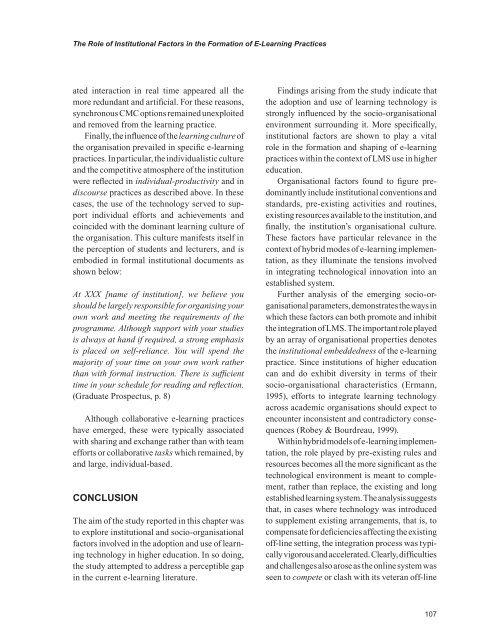Advances in E-learning-Experiences and Methodologies
Create successful ePaper yourself
Turn your PDF publications into a flip-book with our unique Google optimized e-Paper software.
The Role of Institutional Factors <strong>in</strong> the Formation of E-Learn<strong>in</strong>g Practices<br />
ated <strong>in</strong>teraction <strong>in</strong> real time appeared all the<br />
more redundant <strong>and</strong> artificial. For these reasons,<br />
synchronous CMC options rema<strong>in</strong>ed unexploited<br />
<strong>and</strong> removed from the learn<strong>in</strong>g practice.<br />
F<strong>in</strong>ally, the <strong>in</strong>fluence of the learn<strong>in</strong>g culture of<br />
the organisation prevailed <strong>in</strong> specific e-learn<strong>in</strong>g<br />
practices. In particular, the <strong>in</strong>dividualistic culture<br />
<strong>and</strong> the competitive atmosphere of the <strong>in</strong>stitution<br />
were reflected <strong>in</strong> <strong>in</strong>dividual-productivity <strong>and</strong> <strong>in</strong><br />
discourse practices as described above. In these<br />
cases, the use of the technology served to support<br />
<strong>in</strong>dividual efforts <strong>and</strong> achievements <strong>and</strong><br />
co<strong>in</strong>cided with the dom<strong>in</strong>ant learn<strong>in</strong>g culture of<br />
the organisation. This culture manifests itself <strong>in</strong><br />
the perception of students <strong>and</strong> lecturers, <strong>and</strong> is<br />
embodied <strong>in</strong> formal <strong>in</strong>stitutional documents as<br />
shown below:<br />
At XXX [name of <strong>in</strong>stitution], we believe you<br />
should be largely responsible for organis<strong>in</strong>g your<br />
own work <strong>and</strong> meet<strong>in</strong>g the requirements of the<br />
programme. Although support with your studies<br />
is always at h<strong>and</strong> if required, a strong emphasis<br />
is placed on self-reliance. You will spend the<br />
majority of your time on your own work rather<br />
than with formal <strong>in</strong>struction. There is sufficient<br />
time <strong>in</strong> your schedule for read<strong>in</strong>g <strong>and</strong> reflection.<br />
(Graduate Prospectus, p. 8)<br />
Although collaborative e-learn<strong>in</strong>g practices<br />
have emerged, these were typically associated<br />
with shar<strong>in</strong>g <strong>and</strong> exchange rather than with team<br />
efforts or collaborative tasks which rema<strong>in</strong>ed, by<br />
<strong>and</strong> large, <strong>in</strong>dividual-based.<br />
concLusIon<br />
The aim of the study reported <strong>in</strong> this chapter was<br />
to explore <strong>in</strong>stitutional <strong>and</strong> socio-organisational<br />
factors <strong>in</strong>volved <strong>in</strong> the adoption <strong>and</strong> use of learn<strong>in</strong>g<br />
technology <strong>in</strong> higher education. In so do<strong>in</strong>g,<br />
the study attempted to address a perceptible gap<br />
<strong>in</strong> the current e-learn<strong>in</strong>g literature.<br />
F<strong>in</strong>d<strong>in</strong>gs aris<strong>in</strong>g from the study <strong>in</strong>dicate that<br />
the adoption <strong>and</strong> use of learn<strong>in</strong>g technology is<br />
strongly <strong>in</strong>fluenced by the socio-organisational<br />
environment surround<strong>in</strong>g it. More specifically,<br />
<strong>in</strong>stitutional factors are shown to play a vital<br />
role <strong>in</strong> the formation <strong>and</strong> shap<strong>in</strong>g of e-learn<strong>in</strong>g<br />
practices with<strong>in</strong> the context of LMS use <strong>in</strong> higher<br />
education.<br />
Organisational factors found to figure predom<strong>in</strong>antly<br />
<strong>in</strong>clude <strong>in</strong>stitutional conventions <strong>and</strong><br />
st<strong>and</strong>ards, pre-exist<strong>in</strong>g activities <strong>and</strong> rout<strong>in</strong>es,<br />
exist<strong>in</strong>g resources available to the <strong>in</strong>stitution, <strong>and</strong><br />
f<strong>in</strong>ally, the <strong>in</strong>stitution’s organisational culture.<br />
These factors have particular relevance <strong>in</strong> the<br />
context of hybrid modes of e-learn<strong>in</strong>g implementation,<br />
as they illum<strong>in</strong>ate the tensions <strong>in</strong>volved<br />
<strong>in</strong> <strong>in</strong>tegrat<strong>in</strong>g technological <strong>in</strong>novation <strong>in</strong>to an<br />
established system.<br />
Further analysis of the emerg<strong>in</strong>g socio-organisational<br />
parameters, demonstrates the ways <strong>in</strong><br />
which these factors can both promote <strong>and</strong> <strong>in</strong>hibit<br />
the <strong>in</strong>tegration of LMS. The important role played<br />
by an array of organisational properties denotes<br />
the <strong>in</strong>stitutional embeddedness of the e-learn<strong>in</strong>g<br />
practice. S<strong>in</strong>ce <strong>in</strong>stitutions of higher education<br />
can <strong>and</strong> do exhibit diversity <strong>in</strong> terms of their<br />
socio-organisational characteristics (Ermann,<br />
1995), efforts to <strong>in</strong>tegrate learn<strong>in</strong>g technology<br />
across academic organisations should expect to<br />
encounter <strong>in</strong>consistent <strong>and</strong> contradictory consequences<br />
(Robey & Bourdreau, 1999).<br />
With<strong>in</strong> hybrid models of e-learn<strong>in</strong>g implementation,<br />
the role played by pre-exist<strong>in</strong>g rules <strong>and</strong><br />
resources becomes all the more significant as the<br />
technological environment is meant to complement,<br />
rather than replace, the exist<strong>in</strong>g <strong>and</strong> long<br />
established learn<strong>in</strong>g system. The analysis suggests<br />
that, <strong>in</strong> cases where technology was <strong>in</strong>troduced<br />
to supplement exist<strong>in</strong>g arrangements, that is, to<br />
compensate for deficiencies affect<strong>in</strong>g the exist<strong>in</strong>g<br />
off-l<strong>in</strong>e sett<strong>in</strong>g, the <strong>in</strong>tegration process was typically<br />
vigorous <strong>and</strong> accelerated. Clearly, difficulties<br />
<strong>and</strong> challenges also arose as the onl<strong>in</strong>e system was<br />
seen to compete or clash with its veteran off-l<strong>in</strong>e<br />
0


